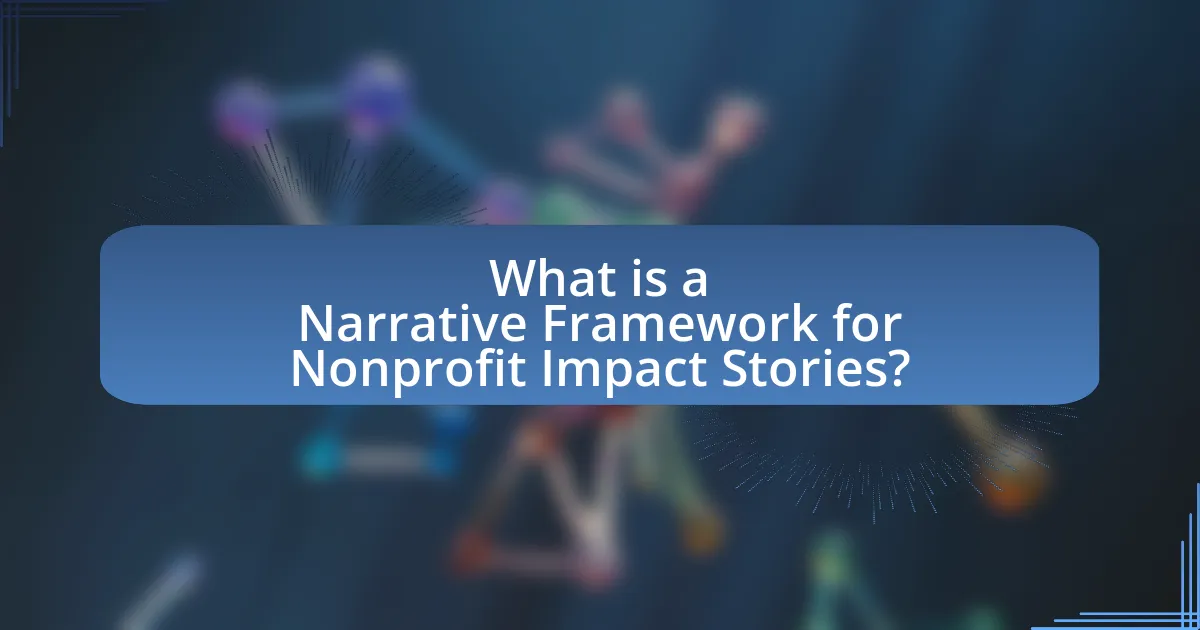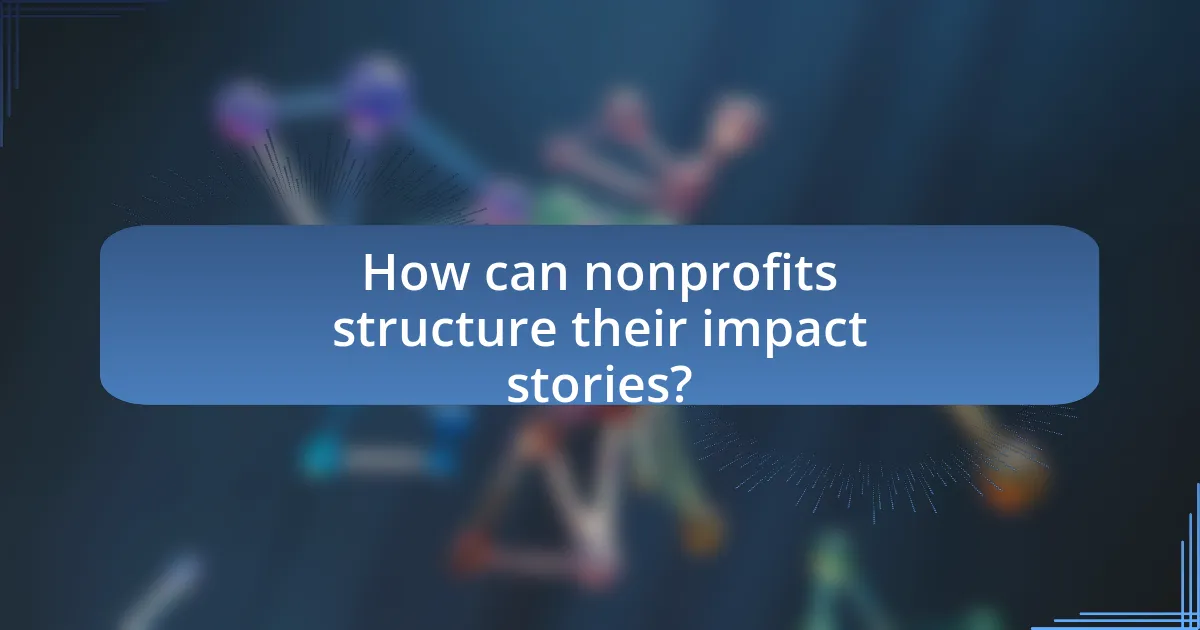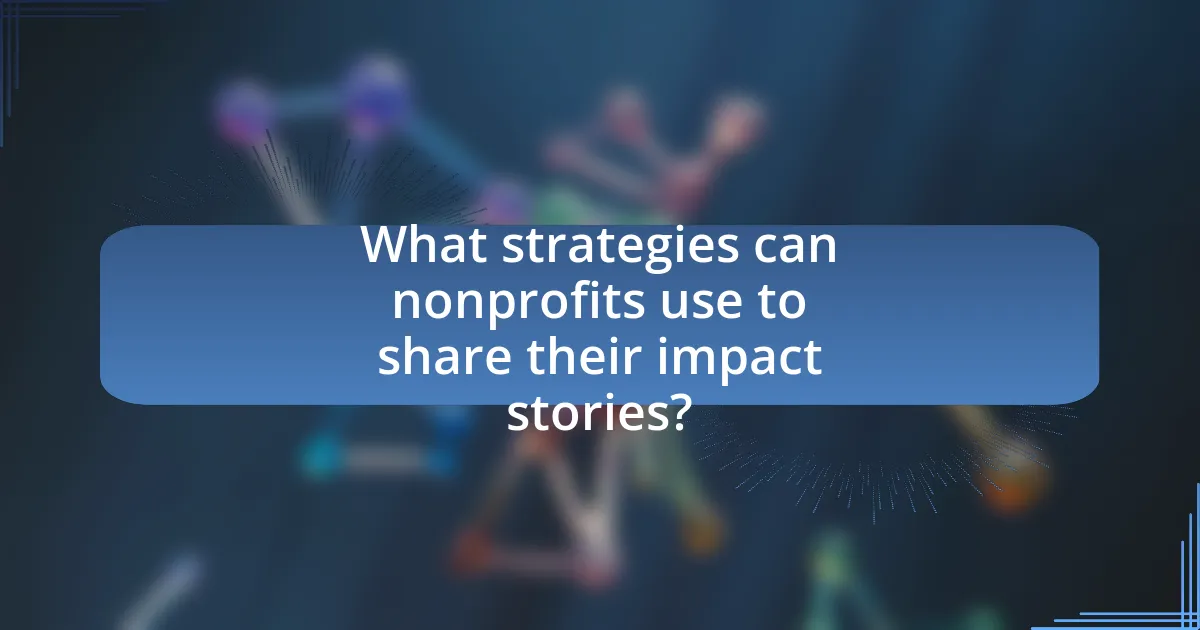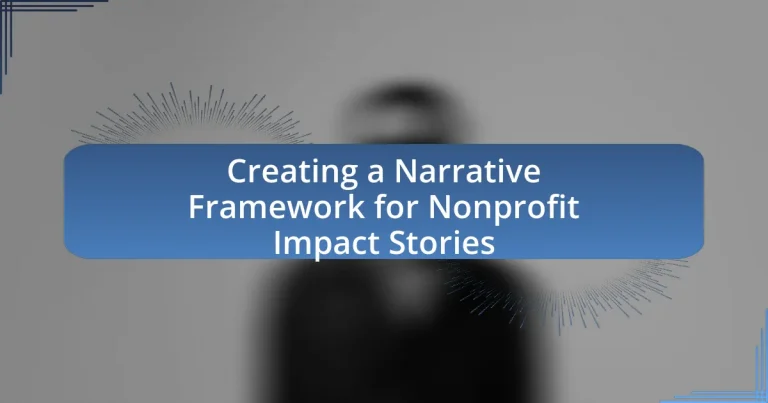A narrative framework for nonprofit impact stories is a structured method that organizations use to effectively communicate their mission, activities, and outcomes. This framework includes essential elements such as a protagonist, conflict, actions taken by the nonprofit, and the resulting impact. The article explores the importance of narrative frameworks in enhancing donor engagement, outlines key components that make up an effective narrative, and discusses how storytelling can significantly influence donor contributions. Additionally, it provides practical strategies for nonprofits to identify and share their unique stories, ensuring authenticity and emotional resonance in their communications.

What is a Narrative Framework for Nonprofit Impact Stories?
A narrative framework for nonprofit impact stories is a structured approach that organizations use to convey their mission, activities, and outcomes in a compelling way. This framework typically includes elements such as a clear protagonist (often a beneficiary), a conflict or challenge faced, the actions taken by the nonprofit, and the resulting impact or resolution. Research indicates that storytelling can significantly enhance engagement and understanding; for instance, a study by the Stanford Graduate School of Business found that stories are 22 times more memorable than facts alone. This demonstrates the effectiveness of a narrative framework in communicating the value and impact of nonprofit work.
Why is a narrative framework important for nonprofits?
A narrative framework is important for nonprofits because it provides a structured way to communicate their mission, impact, and values effectively. This framework helps organizations craft compelling stories that resonate with their audience, fostering emotional connections and engagement. Research indicates that storytelling can increase donor retention rates by up to 50%, demonstrating the effectiveness of a well-defined narrative in enhancing fundraising efforts and community support. By utilizing a narrative framework, nonprofits can clearly articulate their goals and successes, making it easier for stakeholders to understand and support their initiatives.
What elements make up an effective narrative framework?
An effective narrative framework consists of key elements such as a clear structure, relatable characters, a compelling conflict, and a resolution that conveys a meaningful message. The clear structure typically follows a beginning, middle, and end, which helps guide the audience through the story. Relatable characters engage the audience emotionally, making them invested in the outcome. A compelling conflict introduces challenges that the characters must face, creating tension and interest. Finally, a resolution provides closure and reinforces the story’s message, often highlighting the impact of the nonprofit’s work. These elements work together to create a cohesive and impactful narrative that resonates with the audience.
How does storytelling influence donor engagement?
Storytelling significantly enhances donor engagement by creating emotional connections that motivate individuals to contribute. When nonprofits share compelling narratives about their mission and the impact of donations, they evoke empathy and inspire action among potential donors. Research indicates that stories can increase donation likelihood by up to 300%, as they help donors visualize the difference their contributions make. For instance, a study by the Stanford Social Innovation Review found that storytelling effectively communicates complex issues in a relatable manner, leading to higher engagement levels. This emotional resonance fosters a sense of belonging and commitment, ultimately driving donor loyalty and increased financial support.
What are the key components of a narrative framework?
The key components of a narrative framework include characters, setting, plot, conflict, and resolution. Characters are the individuals involved in the story, providing a personal connection for the audience. The setting establishes the context and environment where the narrative unfolds, influencing the mood and tone. The plot outlines the sequence of events and actions that drive the story forward. Conflict introduces challenges or obstacles that characters must face, creating tension and engagement. Finally, resolution ties up the narrative, providing closure and reflecting on the impact of the story. These components work together to create a compelling narrative that resonates with audiences, particularly in the context of nonprofit impact stories, where emotional engagement is crucial for conveying mission and outcomes.
How do mission statements shape impact stories?
Mission statements shape impact stories by providing a clear and focused narrative that aligns organizational goals with the outcomes they aim to achieve. A well-defined mission statement serves as a guiding principle, ensuring that the impact stories reflect the core values and objectives of the organization. For instance, a nonprofit focused on environmental conservation will craft impact stories that highlight specific achievements in sustainability, directly linking back to its mission of protecting the planet. This alignment not only enhances the authenticity of the stories but also strengthens the emotional connection with stakeholders, as they can see the tangible results of the organization’s efforts in relation to its stated mission.
What role do beneficiaries play in storytelling?
Beneficiaries play a crucial role in storytelling by providing authentic perspectives that illustrate the impact of nonprofit initiatives. Their experiences and voices serve as powerful testimonials that humanize the narrative, making it relatable and compelling for the audience. For instance, when beneficiaries share their personal stories of transformation due to a nonprofit’s efforts, it creates an emotional connection that can drive engagement and support. Research shows that stories featuring beneficiaries can increase donor contributions by up to 50%, highlighting their importance in effectively communicating the organization’s mission and impact.
How can nonprofits identify their unique stories?
Nonprofits can identify their unique stories by engaging in reflective practices that highlight their mission, values, and impact. This process involves gathering testimonials from beneficiaries, analyzing the organization’s history, and assessing the specific challenges it addresses. For instance, a study by the Stanford Social Innovation Review emphasizes the importance of storytelling in nonprofit communications, noting that organizations that articulate their unique narratives can better connect with their audiences and enhance fundraising efforts. By focusing on personal experiences and measurable outcomes, nonprofits can craft compelling stories that resonate with stakeholders and differentiate them from others in the sector.
What methods can be used to gather impactful stories?
To gather impactful stories, organizations can utilize methods such as interviews, surveys, and focus groups. Interviews allow for in-depth personal narratives, revealing emotional connections and unique experiences that resonate with audiences. Surveys can collect quantitative data and qualitative insights from a broader audience, identifying common themes and significant impacts. Focus groups facilitate discussions among participants, generating diverse perspectives and deeper understanding of community needs and successes. These methods are supported by research indicating that personal narratives significantly enhance engagement and empathy, making stories more relatable and compelling.
How do personal testimonials enhance narrative frameworks?
Personal testimonials enhance narrative frameworks by providing authentic, relatable experiences that resonate with audiences. These testimonials serve as powerful evidence of the impact and effectiveness of nonprofit initiatives, making abstract concepts tangible. For instance, a study by the Stanford Social Innovation Review highlights that narratives incorporating personal stories can increase engagement and empathy, leading to greater support for nonprofit causes. By integrating personal testimonials, narrative frameworks become more compelling and persuasive, ultimately driving action and fostering a deeper connection between the audience and the mission of the organization.

How can nonprofits structure their impact stories?
Nonprofits can structure their impact stories by following a clear narrative framework that includes a compelling introduction, a description of the problem, the organization’s response, and the outcomes achieved. This structure allows nonprofits to effectively communicate their mission and the significance of their work.
The introduction should capture attention and establish the context, while the problem description outlines the specific issues the nonprofit addresses, supported by relevant statistics or anecdotes. The organization’s response details the programs or initiatives implemented, showcasing the strategies used to tackle the problem. Finally, the outcomes section highlights measurable impacts, such as the number of individuals served or improvements in community well-being, providing concrete evidence of success.
This structured approach not only enhances storytelling but also engages stakeholders by demonstrating accountability and the tangible benefits of the nonprofit’s efforts.
What narrative structures are most effective for impact stories?
Effective narrative structures for impact stories include the hero’s journey, problem-solution, and chronological storytelling. The hero’s journey engages audiences by depicting a protagonist overcoming challenges, which fosters emotional connection and relatability. The problem-solution structure clearly outlines a specific issue faced by a community or individual and presents the organization’s intervention as the solution, making the impact tangible. Chronological storytelling provides a straightforward progression of events, allowing audiences to follow the narrative easily and understand the sequence of actions leading to the impact. These structures are supported by research indicating that stories with clear arcs and emotional resonance significantly enhance audience engagement and retention of information.
How does the hero’s journey apply to nonprofit storytelling?
The hero’s journey applies to nonprofit storytelling by providing a structured narrative framework that resonates with audiences, illustrating the transformation of individuals or communities through the nonprofit’s impact. This framework typically involves stages such as the call to adventure, facing challenges, and achieving a resolution, which can effectively highlight the struggles and triumphs of beneficiaries. For instance, a nonprofit focused on education might depict a student’s journey from adversity to academic success, showcasing the organization’s role in facilitating that change. This storytelling approach not only engages supporters emotionally but also emphasizes the tangible outcomes of donations, thereby reinforcing the nonprofit’s mission and encouraging further support.
What are the benefits of using a problem-solution format?
The benefits of using a problem-solution format include enhanced clarity and engagement for the audience. This format effectively highlights the issue at hand, making it relatable, and then presents a clear solution, which can motivate action. Research indicates that narratives structured in this way are more memorable and persuasive, as they create a logical flow that guides the audience through the problem and its resolution. For instance, a study published in the Journal of Nonprofit & Public Sector Marketing found that storytelling with a problem-solution approach significantly increased donor engagement and contributions.
How can visuals enhance the narrative framework?
Visuals enhance the narrative framework by providing a compelling way to convey complex information and evoke emotional responses. They can illustrate key points, making the narrative more engaging and easier to understand. For instance, studies show that visuals can increase retention of information by up to 65% compared to text alone. This is particularly relevant in nonprofit storytelling, where impactful images or infographics can highlight the urgency of a cause and foster a deeper connection with the audience. By integrating visuals, nonprofits can effectively communicate their mission and the impact of their work, ultimately driving engagement and support.
What types of visuals are most effective in storytelling?
Effective visuals in storytelling include photographs, infographics, videos, and illustrations. Photographs capture authentic moments and evoke emotions, making them powerful for connecting with audiences. Infographics present complex information in a digestible format, enhancing understanding and retention. Videos combine visual and auditory elements, allowing for dynamic storytelling that can engage viewers on multiple levels. Illustrations can simplify concepts and add a unique artistic touch, making narratives more relatable. Research indicates that visuals can increase information retention by up to 65%, demonstrating their critical role in effective storytelling.
How can infographics complement written narratives?
Infographics can complement written narratives by visually summarizing complex information, making it more accessible and engaging for the audience. They enhance understanding by breaking down data into digestible visuals, which can lead to better retention of information. Research indicates that visuals can improve comprehension by up to 400%, as they allow readers to grasp key points quickly and effectively. This synergy between infographics and written content can significantly enhance storytelling in nonprofit impact narratives, ensuring that critical messages resonate with diverse audiences.

What strategies can nonprofits use to share their impact stories?
Nonprofits can use storytelling, social media engagement, and data visualization to effectively share their impact stories. Storytelling allows nonprofits to connect emotionally with their audience by illustrating real-life examples of their work, which can enhance relatability and inspire action. Social media engagement enables nonprofits to reach a broader audience, facilitating the sharing of stories through platforms like Facebook, Instagram, and Twitter, where visual content can capture attention quickly. Data visualization, such as infographics and charts, provides a clear and compelling way to present statistics and outcomes, making the impact more tangible and understandable. For instance, a study by the Stanford Social Innovation Review found that narratives combined with data can increase donor engagement by up to 50%, demonstrating the effectiveness of these strategies in communicating impact.
How can social media be leveraged for storytelling?
Social media can be leveraged for storytelling by utilizing its platforms to share compelling narratives that engage audiences and foster community involvement. Nonprofits can create impactful stories through visual content, such as videos and images, which are more likely to be shared and resonate emotionally with viewers. For instance, according to a study by the Pew Research Center, 69% of adults in the U.S. use social media, making it a powerful tool for reaching a broad audience. Additionally, storytelling on social media allows for real-time interaction, enabling organizations to respond to comments and questions, thus building a stronger connection with their audience. This interactive element enhances the storytelling experience, making it more relatable and impactful.
What platforms are best suited for sharing impact stories?
Social media platforms such as Facebook, Instagram, and Twitter are best suited for sharing impact stories. These platforms enable organizations to reach a wide audience quickly and engage users through visual and narrative content. For instance, Facebook’s user base exceeds 2.8 billion monthly active users, allowing nonprofits to share stories that resonate with diverse demographics. Instagram’s focus on imagery and short videos enhances storytelling, making it ideal for showcasing impactful visuals. Additionally, Twitter’s real-time engagement facilitates conversations around stories, increasing visibility and interaction. These platforms collectively provide tools for storytelling, audience engagement, and community building, making them effective for sharing nonprofit impact stories.
How can nonprofits engage their audience through storytelling on social media?
Nonprofits can engage their audience through storytelling on social media by sharing authentic narratives that highlight their mission and impact. By using real-life stories of beneficiaries, nonprofits can create emotional connections that resonate with their audience, encouraging empathy and support. Research indicates that storytelling can increase engagement rates by up to 300%, as it allows organizations to convey complex messages in relatable ways. For instance, a nonprofit sharing a video of a family positively affected by its services can evoke strong emotional responses, leading to increased shares and donations.
What are best practices for crafting compelling narratives?
Best practices for crafting compelling narratives include establishing a clear structure, engaging the audience emotionally, and using authentic voices. A clear structure typically follows a beginning, middle, and end, which helps guide the audience through the story. Engaging the audience emotionally can be achieved by incorporating relatable characters and real-life experiences, which fosters a connection and enhances the impact of the narrative. Authentic voices, whether from beneficiaries or community members, add credibility and relatability, making the story more compelling. Research by the Stanford Social Innovation Review highlights that narratives that evoke emotions can increase engagement and support for nonprofit causes, demonstrating the effectiveness of these practices in creating impactful stories.
How can nonprofits ensure authenticity in their stories?
Nonprofits can ensure authenticity in their stories by engaging directly with the communities they serve and incorporating their voices into the narrative. This approach fosters genuine representation and builds trust with the audience. For instance, a study by the Stanford Social Innovation Review highlights that stories co-created with beneficiaries resonate more deeply with supporters, as they reflect real experiences and perspectives. By prioritizing transparency and using firsthand accounts, nonprofits can create compelling narratives that accurately depict their impact and mission.
What techniques can improve the emotional resonance of stories?
Techniques that can improve the emotional resonance of stories include the use of relatable characters, vivid imagery, and authentic dialogue. Relatable characters allow audiences to see themselves in the narrative, fostering empathy and connection. Vivid imagery engages the senses, making the story more immersive and emotionally impactful. Authentic dialogue enhances realism, allowing the audience to connect with the characters’ emotions and experiences. Research indicates that stories featuring strong emotional elements can increase audience engagement and retention, as demonstrated in studies by the University of California, Berkeley, which found that emotionally charged narratives are more memorable and persuasive.
What common challenges do nonprofits face in storytelling?
Nonprofits commonly face challenges in storytelling, including limited resources, audience engagement, and message clarity. Limited resources often hinder the ability to produce high-quality content, as many nonprofits operate with tight budgets and small teams. Audience engagement poses a challenge because nonprofits must connect emotionally with diverse stakeholders, which requires understanding their motivations and preferences. Additionally, message clarity is crucial; nonprofits frequently struggle to convey complex issues in a straightforward manner that resonates with their audience. These challenges can impede the effectiveness of their storytelling efforts, ultimately affecting their ability to communicate impact and drive support.
How can nonprofits overcome barriers to effective storytelling?
Nonprofits can overcome barriers to effective storytelling by focusing on clear messaging, audience engagement, and utilizing diverse platforms. Clear messaging ensures that the core mission and impact are communicated succinctly, which is crucial for capturing attention. Engaging the audience through personal stories and relatable content fosters emotional connections, making the narrative more compelling. Additionally, leveraging various platforms, such as social media, blogs, and videos, allows nonprofits to reach wider audiences and adapt their storytelling style to different formats. Research indicates that organizations using multi-channel storytelling see a 30% increase in audience engagement, demonstrating the effectiveness of these strategies in enhancing storytelling capabilities.
What resources are available to assist nonprofits in developing narratives?
Nonprofits can access various resources to assist in developing narratives, including storytelling workshops, online courses, and narrative frameworks specifically designed for nonprofit organizations. Organizations like the Nonprofit Storytelling Conference provide workshops that focus on effective storytelling techniques tailored for nonprofits. Additionally, platforms such as Coursera and Udemy offer online courses on narrative development and communication strategies. The “Storytelling for Social Change” guide by the Center for Story-Based Strategy also serves as a valuable resource, providing frameworks and examples for crafting impactful narratives. These resources collectively enhance the ability of nonprofits to communicate their missions and impact effectively.
What practical tips can nonprofits implement for effective storytelling?
Nonprofits can implement several practical tips for effective storytelling, including focusing on a clear narrative structure, using relatable characters, and incorporating emotional elements. A clear narrative structure helps audiences follow the story, while relatable characters allow them to connect personally with the mission. Emotional elements, such as personal anecdotes or impactful statistics, can evoke empathy and drive engagement. For instance, a study by the Stanford Social Innovation Review found that stories that include emotional appeal can increase donor engagement by up to 50%. By utilizing these strategies, nonprofits can enhance their storytelling effectiveness and better communicate their impact.


